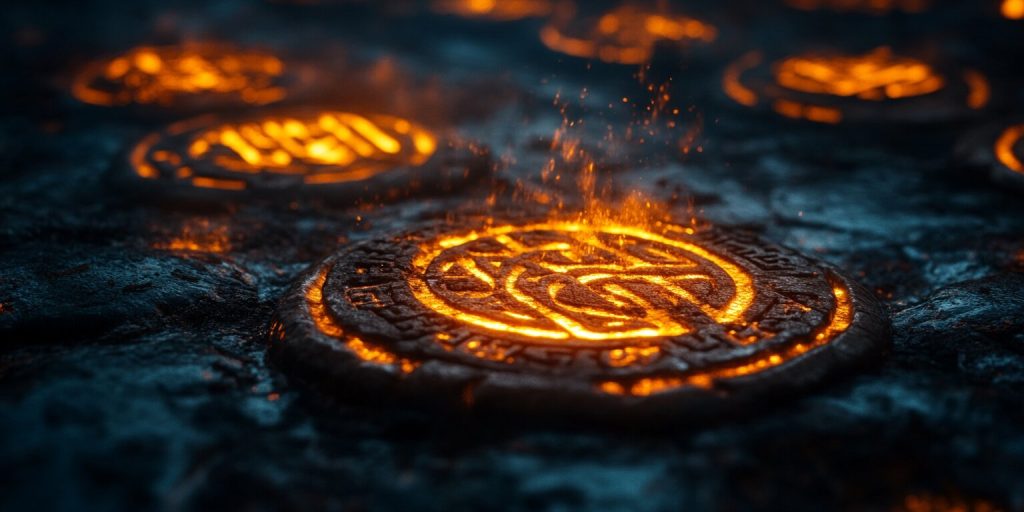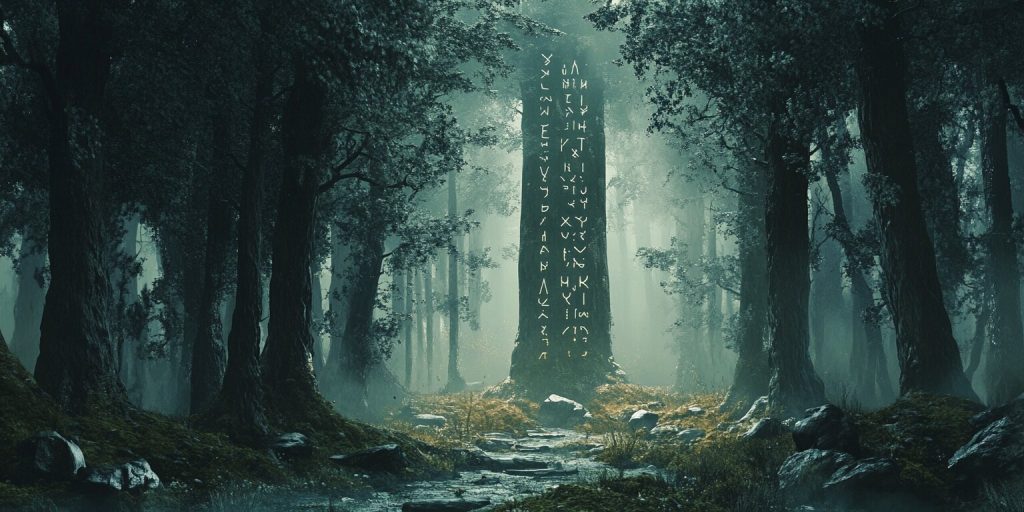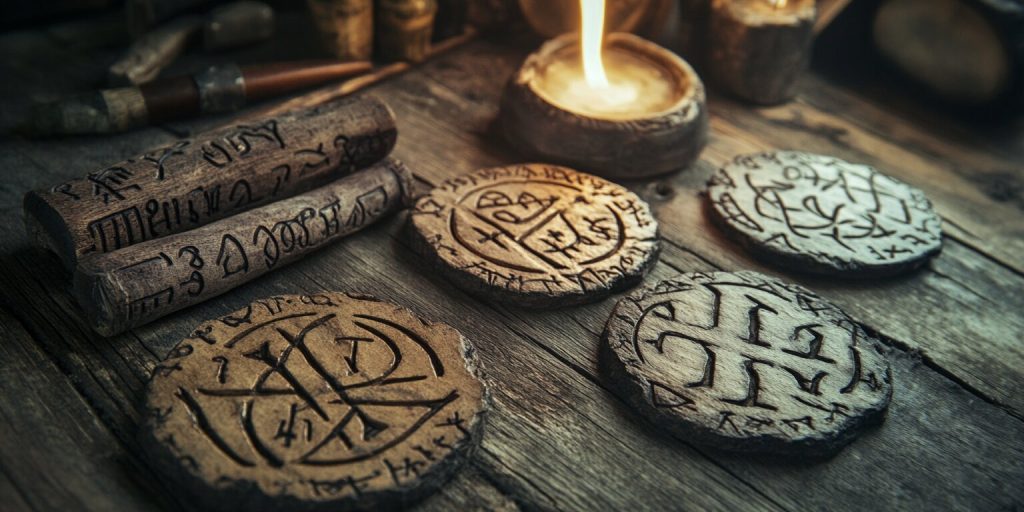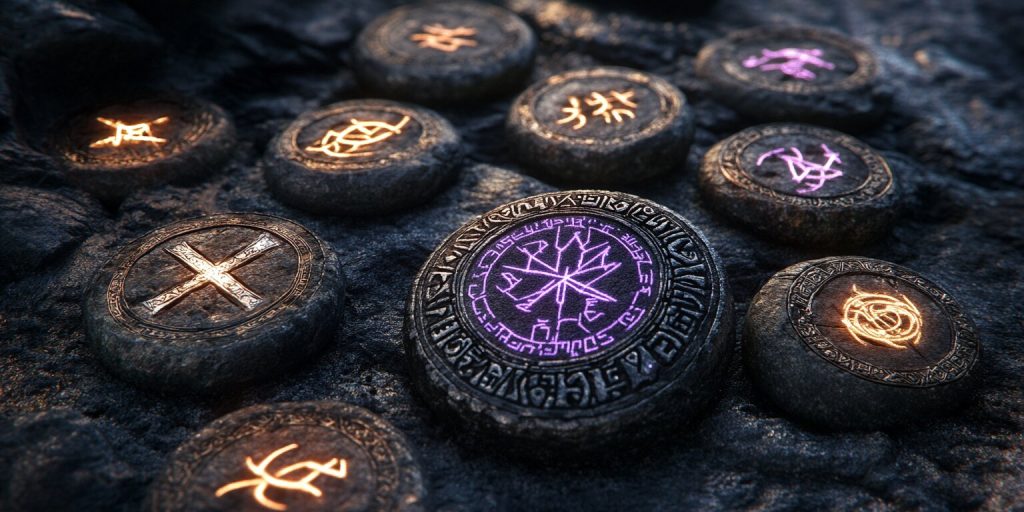Norse Runes, Norse Symbols
Discover the Mystical Art: Magic Norse Runes Demystified
Welcome to the world of magic Norse runes, where ancient symbols meet powerful magic. We’ll explore the origins and meaning of these symbols. They have captured the interest of historians and runic magic users for centuries. Magic runes come from ancient Norse culture. They are more than just tools for fortune-telling; they help with personal growth and spiritual development.
In this article, we’ll examine the history of Norse runes, their unique shapes, and their use in magic and daily life. Let’s start this adventure together. We’ll uncover the secrets of these symbols and see how they’re still important today.
Introduction to Runes and Their Origins
Runes are an old writing system used by the Germanic people. They are closely linked with Norse culture. The word “rune” comes from the Old Norse “rún,” meaning “secret” or “mystery.”
This shows how special and mysterious runes were seen. They were more than just letters.
The runes started around the 1st century AD when the Germanic tribes needed a way to write that fit their language. This writing system became a big part of Norse and Germanic cultures.
At first, runes were used for writing, magic, and myths. In Norse culture, runes did two main things: they recorded events, helped cast spells, and called on the gods.
These special letters have lasted throughout history. They still interest people today.
The Fascinating History of Norse Runes
Norse runes are a key part of Viking history, often seen in runic inscriptions. They were a special writing system tied closely to the culture and beliefs of the Norse. The runes started around the 2nd century AD and became very important during the viking age.
Runes were used for many things in life. Archaeologists have found runic inscriptions and stones that tell us about their beginnings and uses.
Runes were not just letters; they were seen as magical. They were thought to have special powers and connect with the divine, making them important for magic and divination in a society that saw the world as sacred.

As the Viking age turned into the medieval era, runic writing changed. This shows how Norse culture changed with the influence of Christianity. The changes in the runes give us a peek into the Norse worldview and their lasting impact on history.
Understanding the Runic Alphabet
The runic alphabet is a fascinating writing system. It uses futhark runes, each with its own meaning. The Elder Futhark and the Younger Futhark are the main types and have changed significantly over time.
Learning about these alphabets is key to exploring Norse mythology and magic.
The Elder Futhark and Its Significance
The Elder Futhark has 24 runic letters and goes back to the 2nd to 8th centuries, with many runes carved into stones. Each rune is more than a letter; it has deep meanings in Norse culture. Some important runes are:
- Fehu: Represents wealth and prosperity.
- Uruz: Means strength and endurance.
- Thurisaz: It is about protection and defense.
These runes were vital for writing and magic. They help connect people to their spiritual past, often through Viking runes.
Transition to the Younger Futhark
During the Viking Age, the Younger Futhark came about. It had only 16 runes. This change showed how language needs to change over time.
The Younger Futhark kept important symbols but made writing easier for the Norse people.
Some runes in the Younger Futhark are:
- Ás: Connected to gods and spiritual powers.
- Hagall: Means disruption and change.
The move from the Elder to the Younger Futhark shows how runes adapt and how language and culture affect each other. Knowing this helps us understand the runic alphabet’s depth and history.
Magic Norse Runes: Exploring Their Mystical Properties
Magic Norse runes are full of deep mysticism. They are more than just letters. Each rune has its own special meaning and power. People who practice runic magic use these symbols in spells and rituals. They try to change their fate or make their dreams come true.
These runes have long been linked to gods and nature. As part of Viking rune magic, people carve runes to gain protection, wealth, or wisdom. They believe in the runes’ power because they see the world as connected. This includes the universe, nature, and us, as well as the mystical rune magic.
- Divination: Runes are used for fortune-telling. Practitioners look at their meanings to see what the future holds, utilizing runes for divination.
- Rituals: Runes are key in rituals to honor gods or get help and advice in tough times.
- Personal Empowerment: Some use runes to boost their confidence and help in making decisions.
The beliefs about magic Norse runes and rune casting show how important they are in spirituality and culture. Even today, people find meaning in these ancient symbols. They connect with the deep wisdom hidden in them.
What Are Runes Used For? Practical Applications
Runes are important in magic and divination. They have been used for many things throughout history, including rune magic. They help us understand our personal journeys and make decisions.
Use of Runes in Divination and Magic Work
People use runes to get clear answers to life’s big questions. They cast runes to connect with the divine. Here’s how they do it:
- Selecting a set of runes that feel right.
- Shuffling the runes while thinking about a question.
- Drawing runes to see what they mean.
This method shows hidden truths and what might happen next. It helps people understand their lives better.

Carving Runes for Spell Casting
Carving runes is another way to use them magically. People make their own runes for spells, often using symbols from Norse rune magic. Here’s what you might need:
- Natural stones, wood, or metal for a real feel.
- Sharp knives or tools for detailed designs.
- Paint or pigments for the runes to stand out.
Using runes in spells makes the practice personal. It deepens the connection to the magic. This old method helps create spells that match what you want.
Learning about runes reveals their versatility and meaning as magical symbols. They inspire many spiritual practices today.
Runic Symbols and Their Meanings
Runic symbols are very important in Norse culture, particularly in rune casting. Each symbol has its own meaning that adds to their magic. Let’s look at how these runes are used in stories and magic today.
Individual Runes and Their Symbolic Importance
Every rune has special properties that show different parts of life and nature. Here are some important runes and what they mean:
- Fehu (F): Represents wealth and prosperity, often linked to success.
- Uruz (U): Symbolizes strength, health, and vitality, showing physical power and potential.
- Tiwaz (T): Linked to honor and justice, this rune is key for tough decisions.
- Raido (R): Denotes journeys and progress, important for seeking knowledge or self-discovery.
- Kenaz (K): Associated with knowledge, creativity, and illumination, it means enlightenment and insight.
Learning about the runes helps us use them in magic, connecting us deeper with the universe.
Common Combinations of Runes for Magical Practices
Putting runes together can make strong talismans or spells for certain goals. Some common pairs include:
- Protection: Tiwaz and Algiz together bring strength and defense against bad vibes.
- Love: Fehu and Kenaz for bringing passion and warmth to your heart.
- Prosperity: Raido and Fehu bring in wealth and success.
Trying out these pairs shows how versatile runes are in magic. They can help with guidance, power, or change, functioning as magical symbols. Knowing how to use individual runes and pairs can strengthen your runes and magic.
The Role of Runes in Norse Mythology and Culture
Runes are very important in Norse mythology. They are linked closely with Norse culture. Odin, a highly respected Norse god, is often seen as a seeker of wisdom. He got the knowledge of runes by hanging from the world tree, Yggdrasil, for nine nights.

This act shows how deep the connection between runes and wisdom is. Odin’s sacrifice highlights the special bond between the runes and divine insight.
Getting wisdom from the world tree is a key story in understanding runes in Norse culture and their symbolic meaning. Runes were more than just a way to write. They were a sacred language full of magic. They were used in many parts of life and spiritual activities.
- Runes were key in rituals and used as symbols for protection and fortune-telling.
- Artisans and craftspeople added runes to their work, thinking they could make the object more powerful.
- Runes were found on stones and artifacts, showing how they were part of community life. They showed the beliefs and values of Norse society through rune magic.
Runes appear in both myths and everyday life, showing their cultural depth. They connected the ordinary and the magical, adding to the cultural legacy of the Norse people.
Conclusion
Magic Norse runes offer a deep look into an old way of divination and connection to our roots, including rune divination. These symbols have deep meanings and useful ways to apply them, especially in Norse rune magic. They help us understand the mysteries of life. With a long history, runes are more than symbols. They help us grow spiritually and personally.
In this article, we looked at the importance of runes, their history, and their role in Norse stories and today. Many people find strength in the wisdom and guidance runes offer. If you want answers or to know yourself better, magic Norse runes can help.
Runes are still important today, linking the old with the new, often through various forms of rune magic. They inspire us as we search for ourselves, often through rune divination. Let’s explore runes more and let their magic guide us.

